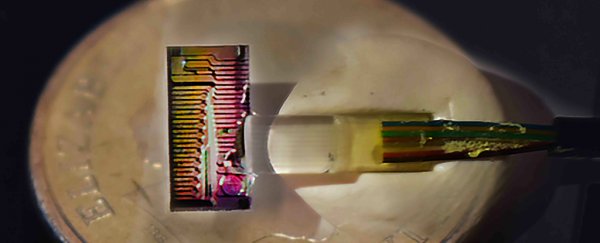A tiny device called a micro-comb could one day replace existing internet infrastructure to hit crazy new highs in download speeds, providing millions with ample data at the same time, even during the busiest periods.
The lightweight technology has recently been put to the test in a field trial that measured data rates of an astonishing 44.2 terabits per second, all emitted from a single light source.
The micro-comb chips themselves aren't exactly new, having been invented around a decade ago. But with rising pressure on our data highways, the technology is now showing promise as a way to slim down and speed up the technology behind our internet.
"It is truly exciting to see their capability in ultra-high bandwidth fibre optic telecommunications coming to fruition," says David Moss, Director of the Optical Sciences Centre at Swinburne University.
"This work represents a world-record for bandwidth down a single optical fibre from a single chip source, and represents an enormous breakthrough for part of the network which does the heaviest lifting."
Engineers from Monash University, Swinburne University, and RMIT in Australia claim a significant benefit of the chip is its ability to make the most of existing infrastructure to meet the demands we can expect in coming years.
The development of Australia's own copper-based, multi-technology-mix national broadband network (NBN) has come under heavy criticism since the government's decision in 2013 to not run optical fibre directly to people's houses.
It was a questionable call that many felt failed to future-proof the internet against rising demands, a prediction that has only been reinforced by the pandemic crisis that's escalated our data consumption habits, as we try to squeeze countless Zoom meetings and TV show episodes through networks of copper and optical fibre.
There's a pressing concern that current systems will struggle in the years to come. Replacing highways of ageing cables to keep up with our needs is an expensive and time-demanding exercise that no doubt will be left up to future generations to figure out.
Meanwhile, there are other components that can be upgraded to help improve the flow of traffic. One of those is the way we currently generate the frequencies of light that carry the bits and bytes down the cables into our computers and smart devices.
Lasers shining at different frequencies can create a multitude of 'channels' to cram information into the tiny refracting tubes. Depending on the way the light is spaced, we can shine as many as 80 channels into the network for all our data needs.
This innovative new micro-comb chip could be set to replace existing methods for creating all of those channels, exchanging 80 separate lasers for a single crystal waveform generator that can be tuned to shape a rainbow of light waves.
On paper, it looks like a great idea. But to make sure their theory was sound, the researchers connected a prototype of the device to more than 76 kilometres (47 miles) of 'dark' optic cable run between two Melbourne university campuses.
The team found they could max out the amount of data for each channel, demonstrating a potential top speed of 44.2 terabits per second from the device. Under ideal conditions with the right system, that would theoretically allow you to download 1,000 movies in a single second. All in high definition!
The reality might not be quite as shiny as downloading all of Netflix in a blink, but with other potential improvements to internet technology on the horizon, even moderate jumps of several terabits per second over short distances are improvements worth paying attention to.
"And it's not just Netflix we're talking about here – it's the broader scale of what we use our communication networks for," says Monash University computer systems engineer Bill Corcoran.
"This data can be used for self-driving cars and future transportation and it can help the medicine, education, finance and e-commerce industries, as well as enable us to read with our grandchildren from kilometres away."
If all goes well, data centres could be using these chips to connect to one another for faster communications.
Maybe in a few years we might all say goodbye to transmitters that shunt data at a paltry few hundred gigabytes per second. Not just in Australia, but around the world.
This research was published in Nature Communications.
